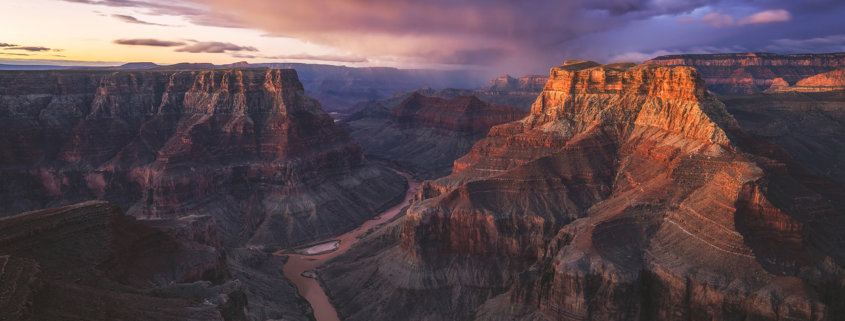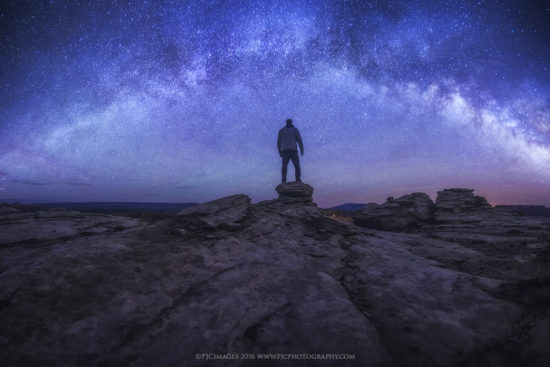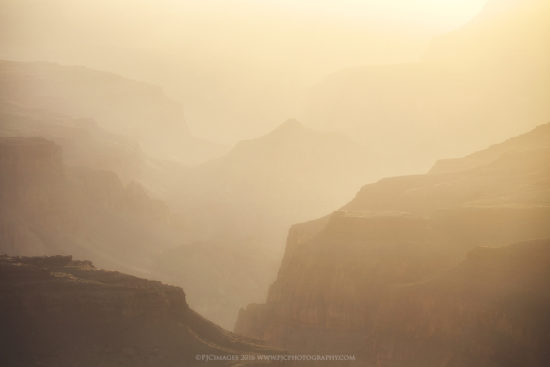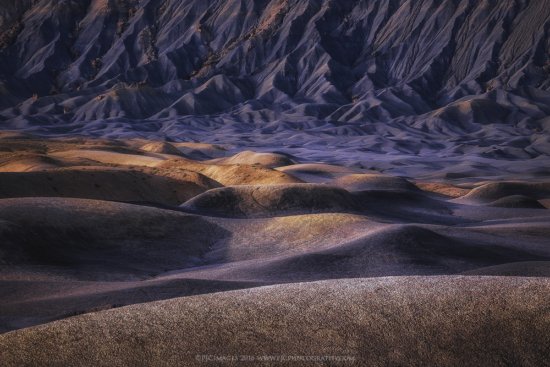Landscape Photography Tips for finding Creativity and Inspiration
I have been a landscape photographer for just over a decade. Professionally, for only a few of those years. When I first picked up a camera, I never thought it was something that would become a career. There have been countless times of self doubt and moments I considered giving up landscape photography altogether. This is something I think all photographers struggle with at some point. I know many other landscape photographers who get down on themselves because they feel their work is no good. Oftentimes, I look at their work and become jealous of an image and wish it were mine.
It’s dangerous to try and hold yourself to a specific standard. One thing many new landscape photographers believe is, if they aren’t good in the first year, then they are a failure. Once again, I have been taking photographs for just over a decade. I can attest that, for the better part of those years, I had no clue what I was doing.

Landscape photography in stormy light over a canyon creating wonderful atmospherics and pastel colors.
Honing your skills as a photographer and artist takes time. So, it is important to keep finding ways to remain inspired, especially if photography is your passion. It’s easy to assume that just looking at some pretty photographs will inspire you to keep shooting. However this is not always the case. We see images daily on social media with a repetition of subject matter and processing styles. I find it easier than ever to become uninspired by this repetition. There are a number of ways to remain inspired without having to look at a photograph. Here are few landscape photography tips to get your started:
#1: Learn from Painters & Artists
Take some time to walk through an art gallery and explore the other art forms that are presented. Oftentimes these are paintings and sculptures. Lately my inspiration comes from past and present painters and learning of new artists in these crafts. Viewing paintings often inspires me to be more creative with my camera and seek out new and unusual perspectives. Because I specialize in landscape photography, I’m often drawn to painters of the same subject. However, it is also nice to gain new perspectives from artists who utilize different subject matter, such as portraiture or abstracts.
#2: Ask for Professional Critiques
Are you struggling with your photographic vision or feel like you don’t know which direction to go? Seek out a professional landscape photographer for critique. Professional critiques can be a great way to discover your path and vision. They are usually honest; so you should have some thick skin to hear what they have to say. I was once told during a critique to toss some of my work into a dumpster and light it on fire. I’m still here with a DSLR camera in hand and I work harder than ever for my photographs. Find a landscape photographer you truly admire for initial inspiration and see if they may be willing to critique your photographs.
#3: Go on a Landscape Photography Workshop
If you are struggling with your compositions, understanding light, or post processing, workshops can be a great learning experience and can often lead to becoming more inspired to create. You should find an instructor with the subject matter and style you are interested in and see if they offer in-field workshops. Learn from these instructors, but be sure not to follow too closely as to emulate and copy their work.
#4: Pursue Creative Landscape Photography
When you travel, it can be easy to be uninspired despite initial excitement. Weather can be less than ideal for your trip, or flowers and fall colors could be too early or too late or just non existent. Instead of feeling uninspired by such conditions, try to maximize what conditions you have by being creative. Oftentimes, this allows you to create images you weren’t even thinking of and they can sometimes be the best images you will create. If you set your expectations too high then you set yourself up for disappointment. If you just go with the flow of things, you will find that you are not as stressed to create a specific type of photograph and the photograph will come to you. This can spark inspiration.
When the conditions are less than ideal for wide angle landscape photography, I tend to look towards the ground for subject matter. During a time when most landscape photographers will have their cameras packed away, I had mine out to photograph the above image of a cactus.
#5: Step our of your Comfort Zone
One thing I’ve noticed is that photography, especially landscape photography, can feel repetitive. While I’m primarily a landscape photographer, I have noticed myself experimenting a bit more with my work than I have before. Stepping out of your normal comfort zone can often be a rewarding and refreshing change to your own work.
Add a Human Element to Landscape Photography
Just this year, I noticed myself adding the human element in a few images and, more recently, incorporating the hand of man in terms of city and roads. I had never worked on such an image before where I felt I needed to incorporate city lights. On a recent trip to Tucson, I found a location that allowed me to expand my creativity while still giving me the landscapes that I love and enjoy. For the image below, I took note of the long road winding around the mountain and the city lights off in the distance. The added bonus here was that the Milky Way would rise above the horizon. Using long exposures to capture the streaking car lights of vehicles heading up and down the mountain, it made the road pop and connected the lights of the city to the light trails on the mountain road. The lights on the road guide the viewer’s eye across the image to the city lights, which drown out part of the Milky Way allowing for almost a split difference in the time of day.
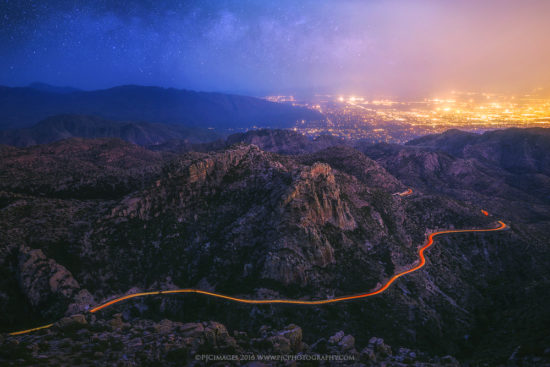
Cars drive up and down Mount Lemmon in Tucson, Arizona as the Milky Way rises above the bright city lights.
Put yourself in the Photo
In addition to including man-made objects, I found myself including… well… myself in a few images. Adding a human element can give more emotional impact and tell more of a story. It can also provide a sense of scale. The image below is a self-portrait I created while camping above Lake Powell. I took note of the Milky Way arching over the lake and obviously made an image of the spectacle for my portfolio. However, after taking that photograph, I decided to play around a bit and make a self-portrait. When I had my finished product, I felt as if I created something more than simply a self-portrait. This was also my first time working on Milky Way panoramic images. When I took the series of images, I had ran back and forth to the small rock to make sure I could get a still image of myself. When processing the image, I noticed that the stitch had omitted me from the entire frame. Thinking I only had a plain and generic Milky Way panoramic, I thought quickly and took that frame to mask into the panoramic image. This definitely added more appeal to the image and allowed the photo to tell a story.
Experiment with different post processing styles
Stepping out of your comfort zone doesn’t must mean shooting different subject matter. Perhaps you take minimal steps for your post-processing to get to your final image. Consider playing around with various techniques and see if they add or subtract to your workflow. I utilized a number of techniques from layer masking, focal point blending, and advanced color work to achieve the final product with the sunset image below. This allowed me to present a more painterly and artistic impression of the scene and, more importantly, helped me create an image which I truly enjoy.
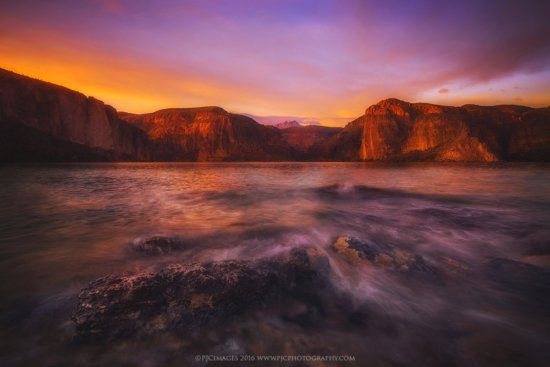
Experimenting with a painterly post processing style – Waves crash on the shores of Canyon Lake at sunset
Other ways to step out of your comfort zone may include using a zoom lens or telephoto lens on the landscape rather than wide angle. Try focusing on the more intimate details and shapes within the scene. This can be more challenging, but I often find the risk is worth the reward. Some areas might not offer this type of opportunity, but it never hurts to look.
Lastly, a great way to remain inspired and creative is to just ignore what others are doing. If you tend to focus on what others are doing, you will lose focus on what you should be doing. This often leads to missing out on opportunities such ignoring specific locations or visiting locations at the wrong times. Even worse, it can lead to taking the completely wrong path for your landscape photography. Focusing on yourself takes away the distraction of what others may be doing, whether they are being successful or not.
Now that you know how to stay inspired and creative all you have to do is grab your camera gear and head out into the wilderness. Good luck.

